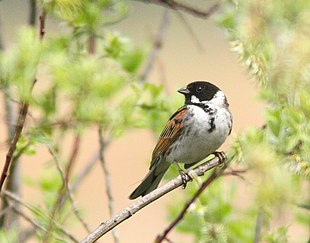Cocuage
Le cocuage en zoologie est la copulation d’un mâle et d’une femelle en dehors du lien social du couple chez les espèces monogames. Dans un système polygame, le cocuage a lieu lorsqu’un individu s’accouple avec un autre n’appartenant pas au groupe social[1],[2].

Le cocuage est un phénomène répandu et bien documenté chez les oiseaux. Des analyses ADN sur la paternité du mâle chez 150 espèces d’oiseaux révèle que dans 70 % des cas, il y a au moins un oisillon de la couvée qui provient d’un autre mâle[1]. Le cocuage s’observe aussi chez les poissons[3] et les mammifères[4].
Une étude révèle que jusqu’à 55 % des rejetons du Bruant des roseaux sont issus d’un autre mâle que celui du couple et que jusqu’à 86 % des couvées hébergent au moins un oisillon provenant d’un autre mâle[5]
Articles connexes
modifierNotes et références
modifier- (en) Griffith, Simon C., Owens, Ian P. F., Thuman, Katherine A., « Extra pair paternity in birds: a review of interspecific variation and adaptive function », Molecular Ecology, Wiley InterScience, vol. 11, no 11, , p. 2195-2212 (ISSN 1365-294X et 0962-1083)
- (en) Lubjuhn, Thomas, Thomas Gerken, Jörg Brün, Tim Schmoll, « Yearling male great tits, Parus major, suffer more strongly from cuckoldry than older males », Zoology, Elsevier Science, vol. 110, no 5, , p. 387–397 (ISSN 1873-2720 et 0944-2006)
- (en) Taborsky, Michael, « Sneakers, Satellites, and Helpers: Parasitic and Cooperative Behavior in Fish Reproduction », Advances in the Study of Behavior, Elsevier, vol. 23, , p. 1-100 (ISSN 0065-3454)
- (en) Munshi-South, Jason, « Extra-pair paternity and the evolution of testis size in a behaviorally monogamous tropical mammal, the large treeshrew (Tupaia tana) », Behavioral ecology and sociobiology, Springer-Verlag, vol. 62, no 2, , p. 1-100 (ISSN 0340-5443 et 1432-0762)
- (en) Dixon A, Ross D, O’Malley SLC, Burke, T., « Paternal investment inversely related to degree of extra-pair paternity in the reed bunting », Nature, Nature Publishing Group, vol. 371, no 6499, , p. 637-724 (ISSN 0028-0836)